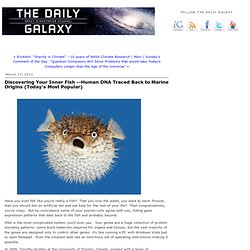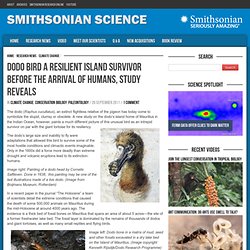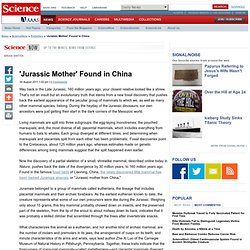

Human DNA Traced Back to Marine Origins. Have you ever felt like you're really a fish?

That you love the water, you want to swim forever, that you should don an artificial tail and eat kelp for the rest of your life? Then congratulations, you're crazy. But by coincidence some of your psycho-cells agree with you, hiding gene expression patterns that date back to the fish and probably beyond. DNA is the most complicated system you'll ever use. Your genes are a huge collection of protein-encoding patterns: some build materials required for organs and tissues, but the vast majority of the genes are designed only to control other genes: it's like running a PC with Windows Vista just to open Notepad. In 2009, Timothy Hughes at the University of Toronto, Canada, worked with a team of researchers to investigate evolutionary alterations in gene regulation in the five different vertebrates. Bittersweet Adaptation: How Genes For Survival May Be Giving Us Diabetes « WiSci.
The famous phrase has it that evolution is a process of the “survival of the fittest.”

However, it should be noted that this doesn’t imply some great evolutionary gymnasium, with species pumping and sculpting themselves into the most sexually appealing shapes of the day. Rather, the phrase means something more like “the survival of the aptest”—that is, that those whose bodies are genetically best “fitted” to their environment are those who are most likely to survive and to pass their extra-suitable genes on to future generations. Recent research has brought this distinction very much to life for humans living in the sugar- and fat-rich developed world, one in which burger joints and donut shops are often found on every other block. In what is, in evolutionary terms, a brand new environment, genetic adaptations that were essential for early human survival—those designed to preserve as much fat and energy as possible—are now perhaps major contributing factors in making many of us unfit.
Mammoth Amount of Ice Age Fossils Found in Colorado. Nearly all marine fish came from freshwater ancestors. I’m sure that most of us think that marine fish evolved in the sea, but a new paper by Greta Vega and John Wiens in the Proceedings of the Royal Society (B) says that that just ain’t so. The vast majority of them evolved from ancestors who lived in fresh water (themselves derived from marine ancestors) and then re-invaded the sea—just as marine mammals evolved from terrestrial mammals whose distant ancestors were aquatic. As Vega and Wiens point out, compared to the land, the sea is biologically depauperate: marine habitat covers 70% of the Earth’s surface but contains only 15-25% of Earth’s species. It gets worse if you count “habitable space”: since the ocean is three-dimensional, Vega and Wiens claim that it contains “90-99% of the volume of the habitable biosphere.”
Why this relative lack of marine species compared to those on land (or freshwater)? Fig. 1 from Vega and Wiens (2012) You may wonder what fish are in those three freshwater “basal” groups. The bowfin, Amia calva Vega, G. Did Whale Evolution Go Backwards? Virus Evolution. Macroevolution and Microevolution Compared and Related. The term “evolution” is commonly thought as the process that leads to diversification of species or to gradual change in certain characteristics of living organisms.

However, biologists often distinguish this definition of evolution from evolution that involves genetic changes at the population level. Macroevolution Explained. Yeti crab grows its own food : Nature News & Comment. Mass Species Loss Stunts Evolution for Millions of Years. When searching for causes of Earth's mass extinctions, scientists instinctively turn to geophysical calamities: erupting volcanoes, methane bursts, asteroid strikes and other obvious dooms.

But in the most massive extinction of all, when most of everything that lived died out some 250 million years ago, a more subtle form of destruction has been suggested. Following an initial volcanic upset, the loss of life itself may have fueled further extinctions, then slowed life's recovery. That possibility, suggested by massive analyses of fossils and chemical signals left during the Permian-Triassic extinction event, represents more than an interesting wrinkle to a notable period in history. By this reading of the fossil record, biological diversity – something that's now imperiled by human appetites – may be a sustaining, stabilizing force on planetary scales, and its disruption self-perpetuating.
Dodo bird a resilient island survivor before the arrival of humans, study reveals The dodo (Raphus cucullatus), an extinct flightless relative of the pigeon has today come to symbolize the stupid, clumsy or obsolete.

A new study on the dodo’s island home of Mauritius in the Indian Ocean, however, paints a much different picture of this unusual bird as an intrepid survivor on par with the giant tortoise for its resiliency. The dodo’s large size and inability to fly were adaptations that allowed this bird to survive some of the most hostile conditions and climactic events imaginable. Only in the 1600s did a force more deadly than extreme drought and volcanic eruptions lead to its extinction: humans. Image right: Painting of a dodo head by Cornelis Saftleven. 'Jurassic Mother' Found in China. Way back in the Late Jurassic, 160 million years ago, your closest relative looked like a shrew.

That's not an insult but an evolutionary truth that stems from a new fossil discovery that pushes back the earliest appearance of the peculiar group of mammals to which we, as well as many other mammal species, belong. During the heyday of the Jurassic dinosaurs, our own ancestors were just getting their start in the dark corners of the Mesozoic world.
Living mammals are split into three subgroups: the egg-laying monotremes; the pouched marsupials; and, the most diverse of all, placental mammals, which includes everything from humans to bats to whales. Each group diverged at different times, and determining when marsupials and placentals split from each other has been problematic. Fossil discoveries point to the Cretaceous, about 125 million years ago, whereas estimates made on genetic differences among living mammals suggest that the split happened even earlier. Discovery of a 160-million-year-old fossil represents a new milestone in early mammal evolution. Discovery of a 160-million-year-old fossil represents a new milestone in early mammal evolution.